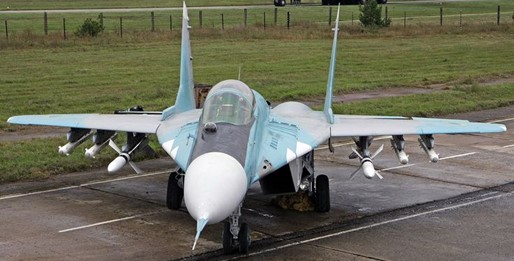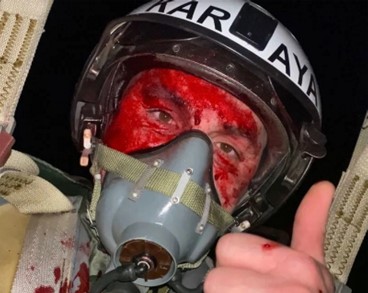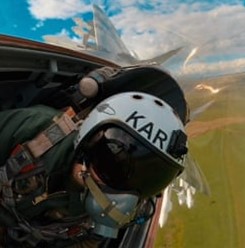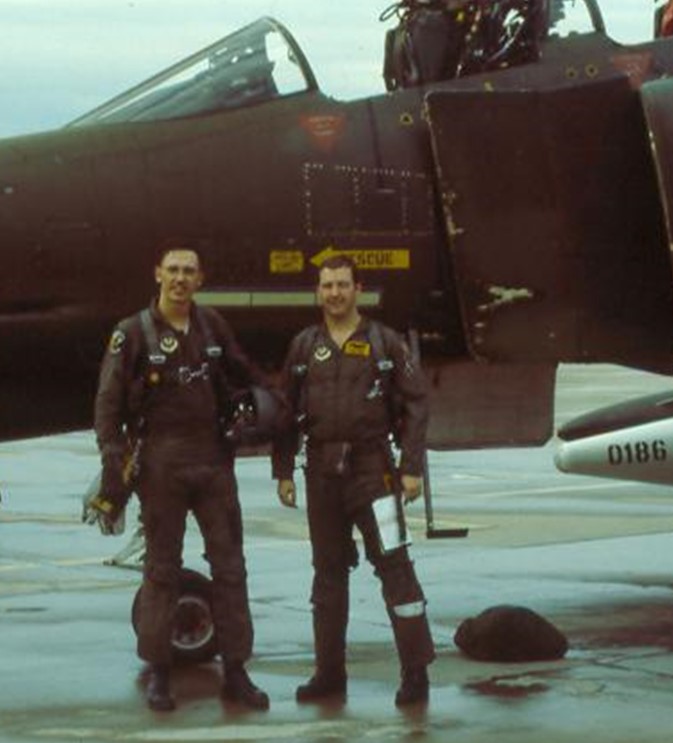By: Warren Gray
Copyright © 2023
“I try to live one day at a time, or rather, right now and right here…
Now, if there is an opportunity to do something, you should definitely
do it – don’t put it off. No one knows whether tomorrow will come.
We must not stop, we must live here and now.”
— Major Vadym Voroshylov, December 28, 2022
On Wednesday, October 12, 2022, Ukrainian Air Force Major Vadym Voroshylov, age 28, a veteran of 20 combat missions already, was at the controls of his MiG-29S Fulcrum-C jet fighter (#10) in the skies over the Vinnytsia region of south-central Ukraine, with the radio callsign of “Karaya” (“Kuh-rye-uh”) emblazoned across the front of his white flight helmet in bold, black lettering.
This was the same famous callsign (actually, “Karaya One”) used by the German fighter ace (but not a member of the Nazi Party) Major Erich Hartmann, ages 20 to 23, in World War Two, the highest-scoring fighter ace of all time, with 352 confirmed aerial kills to his credit. It was based upon an exotic, fairytale love song by young German singer Mimi Thoma, and recorded sometime between 1938 and 1942. In the song, Karaya was the daughter of the king of Malaya (now Malaysia), and she was courted by a native chief named Chum, “Where the moon is so pale, and the mouth kisses so softly.” Hartmann’s fighter squadron had a shortage of phonograph records to be played for pilot morale in the field, but the love song “Karaya” was one of them, and they played it over and over again, becoming known as the “Karaya” squadron.
Interestingly enough, Hartmann flew the vast majority of his combat missions from Ukrainian territory, against the Russians, including 1,404 combat missions, earning Germany’s highest award for valor, the Knight’s Cross with Oakleaves, Swords, and Diamonds, equivalent to a U.S. Distinguished Service Cross and three Medals of Honor! He flew Messerschmitt Bf 109G-6 and Bf 109G-10 “Gustav” fighters from Ukrainian bases in Zaporizhzhia, Kharkov-Rogan (now Kharkiv-Rohan), and Novokrasne from 1942 through 1944, scoring most of his 28th through 248th air-to-air kills against the Soviet Air Force there, in the skies over Kharkov, Zaporizhzhia, Fedorivka, and Sevastopol.
So, with this shining example of an air force major and fighter pilot attacking Russians from Ukrainian soil, young Vadym Voroshylov saw striking, historical parallels, and adopted the callsign “Karaya” as his own motivational moniker.

Major Vadym Voroshylov, calling “Karaya”. Photo credit: Vadym Voroshylov-Instagram
On December 28, 2022, the Ukrainska Pravda (“Ukrainian Truth”) news media published an interview with Major Voroshylov, in which he stated that, “The story of my callsign goes way back to 2014 (actually, two years before he joined the air force), when the Russians launched their propaganda machine and started calling Ukrainians ‘Nazis’…I knew about Hartmann. So, I decided to sign it as ‘Karaya.’ It was mostly a joke, precisely because of the Russian propaganda, to make fun of them (laughs)…Everyone knows that Hartmann was a genius pilot. He went through Stalin’s camps (as a political prisoner from 1945 to 1955), then served in West Germany (air force), and even trained American pilots.”
In the Ukrainian language, the words kara and karaty, sounding somewhat similar to Karaya, mean “punishment” or “punished,” so Ukrainians who don’t know the Karaya song could easily misinterpret his callsign as “Punisher,” which is rather fitting.
On October 12, 2022, Voroshylov explained, “My morning started at four o’clock. The air-raid signal was sounded. One pilot destroyed two (Iranian-made, Russian-operated) Shahed UAVs (Shahed-129 or -136, or ‘Martyr’ drones) in Ukraine’s south. I was the next to go. I took off from an operational airfield in Ukraine’s south.” He headed for Vinnytsia, a city known for the brutal terrors of Soviet/Russian and Nazi occupation in the past.
The Vinnytsia Massacre, part of the Great Purge under Joseph Stalin’s dictatorial, communist rule, was the secret, mass execution of nearly 11,000 innocent civilians from 1937 to 1938 by the Soviet NKVD secret police. The victims were naked, with their hands tied behind their backs, and most of them were shot twice in the back of the neck with a .22-caliber handgun.
This was a particularly cruel method, which usually did not cause instantaneous death. The victims were often paralyzed, choking on their own blood, and sometimes taking several agonizing minutes to die. The invading Nazi army discovered the mass graves in May 1943, and sponsored an international commission of experts to reveal the horrors of the clandestine, Soviet bloodbath. Of course, the Nazis never mentioned that they themselves had already exterminated 58,000 Jews in Vinnytsia on September 16th and 22nd, 1941, mostly by 7.65mm and 9mm gunshots to the back of the neck. Most ironically, the current president of Ukraine, Volodymyr Zelenskyy, is Jewish.
Vadym’s MiG-29S was fully loaded for air combat with two AA-10C (R-27ER) Alamo radar-guided missiles, four heat-seeking AA-11 (R-73M) Archers, and a single GSh-30-1 30x165mm cannon in the left wing root, with 150 rounds loaded. MiG-29 designer Mihail Romanovič Valdenberg stated that had he known that this gun was so accurate, he would have specified only half the ammunition load, and saved some weight.

Ukrainian MiG-29S Fulcrum-C with full load of AA-10C and AA-11 missiles, and 30mm gun. Photo credit: Max Bryansky
While air-to-air combat usually involves opposing fighter aircraft, Russia’s staggering losses of more than 300 fixed-wing aircraft, 288 helicopters, 2,058 drones, and 873 cruise missiles shot down (as of March 2, 2023) by Ukrainian fighters and antiaircraft missiles caused them to revise their aerial tactics, and the fighters now avoid Ukrainian airspace. Voroshylov remarked that, “They don’t enter the target zone of our tactical aircraft. They are afraid to, and they insidiously make (missile) launches on the territory of Ukraine…We would completely paralyze the enemy in Ukrainian airspace.”
Fighter tactics over eastern Ukraine are further complicated by the presence of Ukrainian long-range, SA-10D (S-300PS, with 56-mile range) Grumble surface-to-air missile batteries in Dnipro and Nikopol, opposed by Russian ultra-long-range, SA-21B (S-400 Triumf, with 248-mile range) Growler missile batteries at Rostov-on-Don and Dzhankoi Air Base (Crimea), so any flight activity in that region is especially perilous.
Instead of finding Russian fighters in the morning skies over Vinnytsia, he discovered Shahed reconnaissance drones and suicide-attack drones, noting that, “As combat operations have shown, the efficiency of reconnaissance aviation and the effectiveness of drones in suppressing air defence systems is an extremely important element of weapons…For me, any target is very important. Even a reconnaissance UAV is something that brings death to Ukrainian civilians and military personnel.”

Major Vadym Voroshylov and his MiG-29S wingman. Photo credit: Vadym Voroshylov-Instagram
So, Major Voroshylov was prowling the morning skies in his MiG-29S Fulcrum, on the lookout for Russian-flown, Shahed drones south of his base. He already had two confirmed kills to his credit, Russian cruise missiles shot down on previous missions, and was a seasoned combat pilot.
When asked in his December interview, “Have you seen the film, Top Gun?” he replied, “Of course (smiles.) I am a fan of the first part…Regarding the second part of Top Gun, I will say that it is a very beautiful, aesthetically filmed, fairy tale. There are many shots of real piloting. But the conduct of air battles, the work of the antiaircraft missile systems – they don’t quite reflect reality (smiles).”
Near Vinnytsia, Voroshylov detected several Shahed drones, and, “I also destroyed three, (and) landed at the operational airfield with no incidents.” Then, he continued his normal, ground duties at his base, and that evening, the Russians launched another attack, and Vadym scrambled once again, “and then destroyed (two more) air targets over the skies of Vinnytsia.”
Soon, he was closing in on yet another Shahed drone: “I locked on and intercepted the fifth air target and, sadly, after the target had been destroyed, my aircraft was damaged by wreckage from the explosion.” The cockpit glass and the nose of the aircraft were destroyed, and Vadym suffered numerous facial cuts. He was covered in blood, which made it difficult for him to fully assess the grim situation. “There was a settlement ahead. I checked the aircraft controls: they were already partially out of service. Seeing a black area in front of me, I assumed that it was a field. Then, the fire started inside the cockpit. And when the flames started to reach me, I ejected with no delay.”
During his two-minute descent by parachute, Voroshylov had the unusual presence of mind to take a “selfie” photo with his cell phone to assess his injuries and overall condition. He later published the photo online to encourage others, emphasizing that, “This is the message that our nation cannot be defeated.”

Major Voroshylov, hanging beneath his parachute. Photo credit: Vadym Voroshylov-Instagram
Once on the ground, a pilot employs his seat survival kit. Another Ukrainian MiG-29 pilot, using the callsign “Juice,” told The War Zone on April 2, 2022, that, “In terms of personal survival…the original, Soviet-supplied, survival kit was ‘bullshit…and even the Russians tell (us) the same.’ Instead, the Ukrainian pilots fly into combat with their own survival kits, based on commercially available vests that can accommodate a pistol (often personally owned), first-aid items, navigation aids, and sometimes even grenades. The original survival kit included an AKS-74U compact assault rifle (with short, 8.1-inch barrel) under the seat…Some pilots still have the rifle under their seat, while others opt to carry it in the cockpit (not a good idea, if the pilot has to eject).”
Fortunately, Voroshylov parachuted onto friendly soil, and was taken in and cared for by a Ukrainian couple, before spending some time in a hospital to recover from his facial injuries. Only three days later, the Ukrainian Ministry of Defense told his dramatic story for the entire world to read.
It takes five confirmed, air-to-air kills to be recognized as an “ace” pilot, and Erich Hartmann was the greatest ace of all time, with 352 total kills, and at least three “ace-in-a-day” events of five or more kills in a single day. Vadym Voroshylov achieved “ace-in-a-day” status on October 12, with seven total kills to his credit. The Ukrainian Ministry of Defense calls him the “Shahed Killer,” and local residents of Ukraine have reverently named him “The Ghost of Vinnytsia.” He is Ukraine’s only known ace pilot to date. Ukrainian President Volodymyr Zelenskyy personally presented him with the Hero of Ukraine medal, equivalent to the U.S. Medal of Honor, for his incredible deeds in combat.
In World War Two, Erich Hartmann typically closed to within 20 meters (66 feet) of Russian aircraft before opening fire, partly to compensate for the poor ballistic trajectory of his low-velocity, 20x82mm cannon rounds (or heavier, 30x90RBmm rounds in the Bf 109G-10 aircraft), and as a result, Hartmann had to crash-land his own various aircraft 16 times, often due to flailing debris from the enemy aircraft that he destroyed. Voroshylov channeled his inner Karaya persona, and did essentially the same thing at point-blank range, losing his own fighter to the debris from an exploding Shahed drone.
Now, he has been issued another MiG-29 (#47) and continues the fight: “Many thanks to the people of Vinnytsia, the people of Ukraine, who gave such words of support. I am ready to take up the wing again and continue to destroy the enemy…We…are absolutely ready for anything. We use more modern methods (often taught by U.S. Air Force pilots), which are not written in any textbook of any country in the world.”
On October 15, 2022, a Ukrainian named Niklas tweeted, “Give him an F-35 (Lightning II stealth fighter), and he will win this war for Ukraine once and for all.”
When asked about the future, Vadym responded, “The first thing we need is to increase the range that our radar and sighting systems can see. The second is air-to-air, guided weapons with a much longer range than we have now. So, we really need F-16s that can meet our needs in that regard…Western-type fighters will help to reveal 100 percent of our potential…thanks to our Western partners…the F-16 will greatly improve the situation and help our defense forces as a whole.”
According to Ellie Cook of Newsweek magazine on March 5, 2023, “(Two) Ukrainian pilots are being trained to fly the fourth-generation F-16s in (Tucson) Arizona…‘undergoing an assessment’…to see how long it would take them to complete training on aircraft, including F-16 fighters…(which) ‘will ensure pilots are able to fly sophisticated, NATO-standard, fighter jets in the future’…(However) It would take three to six years to deliver advanced, ‘new-production’ F-16s to Kyiv.”

Major Vadym Voroshylov flies a fully armed MiG-29. Photo credit: Vadym Voroshylov-Instagram
Meanwhile, Slovakia has delivered four used MiG-29s to Ukraine, with nine more to be delivered in coming weeks. Slovakia had previously signed a deal to buy 14 F-16 fighter jets from the U.S., but they won’t be delivered until next year. Slovak Defense Minister Jaroslav Nad announced that, “Slovakia is on the right side, and with this gesture, we as a country have written ourselves in capital letters in modern world history, which speaks of timely help, sincere solidarity and the greatness of the nation.”
In addition, Ukraine has upgraded eight of its existing MiG-29S Fulcrum-C fighters to MiG-29MU1 (Modernized, Ukraine, Type 1) configuration with improved, N019-19 Topaz radars having a range of 62 miles, and carrying longer-range, AA-10C/D Alamo missiles normally employed by larger, Su-27 Flanker fighters.
MiG-29 pilot “Juice,” referring to the difficult processes of acquiring Western weapon systems and training, candidly added that, “We understand it’s f***ing expensive. It’s like science fiction for us at the moment, but we need…to start the modernization of our air force right here and right now, fighter jets as well as ground air defense…We are not able to defend our ground forces, our civilians, our families, and children…the issue of air superiority and of ground air defense is one of the most important in this war. We are losing our men on the ground and in the air.”
Major Voroshylov concluded that, “I consider victory to be when the enemy’s power and politics change. Ideally, victory is the collapse of the (Russian) empire. And of course…the restoration of Ukraine’s territorial integrity, and the return of all occupied territories, together with Crimea.”
Those were bold words, spoken candidly by a very bold pilot, a genuine, Ukrainian hero, affectionately known as “The Ghost of Vinnytsia.” We all need heroes, to inspire us and show us what is truly possible, with strength, courage, determination, willpower, and resolve. The besieged and embattled Ukrainian people especially need heroes as this brutal and seemingly endless invasion by Russian forces drags on well into its second year, and they continue to fight for their very lives and national survival against overwhelming odds. Vadym Voroshylov is the kind of exemplary hero that inspires them to fight on, despite setbacks and losses, toward a noble goal of absolute victory.
* * *

Author (on left) with F-4E Phantom II jet fighter in Spain, 1985. (Photo by author)
Warren Gray is a retired, U.S. Air Force intelligence officer with experience in joint special operations and counterterrorism. He served in Europe (including Eastern Europe, and with two American fighter squadrons in Germany) and the Middle East, earned Air Force and Navy parachutist wings, four college degrees, and was a distinguished graduate of the Air Force Intelligence Operations Specialist Course, and the USAF Combat Targeting School. He is currently a published author, historian, and hunter. You may visit his website at: warrengray54.vistaprintdigital.com

